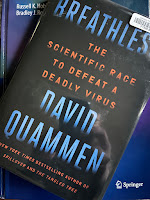 |
| Breathless, by David Quammen. |
To some people it wasn’t surprising, the advent of this pandemic, merely shocking in the way a grim inevitability can shock. Those unsurprised people were infectious disease scientists. They had for decades seen such an event coming, like a small, dark dot on the horizon of western Nebraska, rumbling toward us at indeterminable speed and with indeterminable force, like a runaway chicken truck or an eighteen-wheeler loaded with rolled steel. The agent of the next catastrophe, they knew, would almost certainly be a virus. Not a bacterium as with bubonic plague, not some brain-eating fungus, not an elaborate protozoan of the sort that cause malaria. No, a virus—and, more specifically, it would be a “novel” virus, meaning not new to the world but newly recognized as infecting humans.Quammen—a national treasure—is writing about covid (or, to use its official name, SARS-CoV-2). The coronavirus pandemic did not startle him; he almost predicted it in his earlier book Spillover. Quammen’s book Breathless is to tracing the origins and variants of covid as Walter Isaacson’s book The Code Breaker is to developing a vaccine for covid: required reading to understand what we’ve all been through the last three years. (And what I went through last month with my first case of covid, but I’m healthy now and feeling fine.)
Breathless describes the scientists who developed amazing software to analyze the virus’s genome, such as Áine O’Toole’s genomic pipeline PANGOLIN. Intermediate Physics for Medicine and Biology doesn’t discuss computational genomics, but at the heart of IPMB is the idea that you can combine a hard science like computer programming with a biological science like genomics to gain more information about, and insight into, biology and medicine. Quammen interviewed O’Toole about her experience writing the PANGOLIN program (“O’Toole stayed up late one night, and the next morning, there it was.”). But he didn’t interview just her. He talked to 96 heroic scientists and medical doctors who sought to understand covid, from those I’ve never heard of such as O’Toole to those we all are familiar with such as the brilliant Anthony Fauci. These interviews give the book credibility, especially given all the covid conspiracy theories and anti-vaccine nonsense that floats around the internet these days.
For anyone who may doubt the reality of evolution, I challenge you to try making sense of covid variants without it. Quammen takes us through the list: Alpha, Beta, Gamma, and the frightening Delta.
And after Delta, we knew, would come something else. The Greek alphabet contains twenty-four letters; at that point, the WHO [World Health Organization] list of variants only went up to mu. A virus will always and continually mutate, as I’ve noted, and the more individuals it infects, the more mutations it will produce. The more mutations, the more chances to improve its Darwinian success. Natural selection will act on it, eliminating waste, eliminating ineptitude, carving variation like a block of Carrara marble at the hands of Michelangelo, finding beautiful shapes, preserving the fittest. Evolution will happen. That’s not a variable, it’s a constant.The latest variant, Omicron, seems to have appeared just as Quammen was finishing his book.
Omicron’s panoply of mutations reflects a period of active, extensive evolution—because the mutations not only occurred but they were preserved, within the lineage, suggesting they offered adaptive value.One of the most interesting questions addressed in Breathless is the source of covid. Was it a lab accident, a spillover from an animal host (called a zoonotic event), or a malevolent attempt at biological warfare? Quammen doesn’t provide a definitive answer, but he favors the conclusions reached in a review article written by a group of prominent virologists led by Eddie Holmes.
Yes, Holmes and his coauthors agreed, the possibility of a lab accident can’t be entirely dismissed. Furthermore, that hypothesis may be nearly impossible to disprove. But it’s “highly unlikely,” they judged, “relative to the numerous and repeated human-animal contacts that occur routinely in the wildlife trade.” Failure to investigate that zoonotic dimension, with collaborative studies, crossing borders between countries and boundaries between species, would leave this pandemic festering and the world still very vulnerable to the next one.Run, do not walk, to your library or bookstore and get Breathless. You need to read this book. Take special heed of Quammen’s alarming, disturbing, terrifying last sentence.
There are many more fearsome viruses where SARS-CoV-2 came from, wherever that was.
A conversation with author and journalist David Quammen.



Wow, this sounds like a book that's right up my alley! Thank you for the recommendation!
ReplyDelete